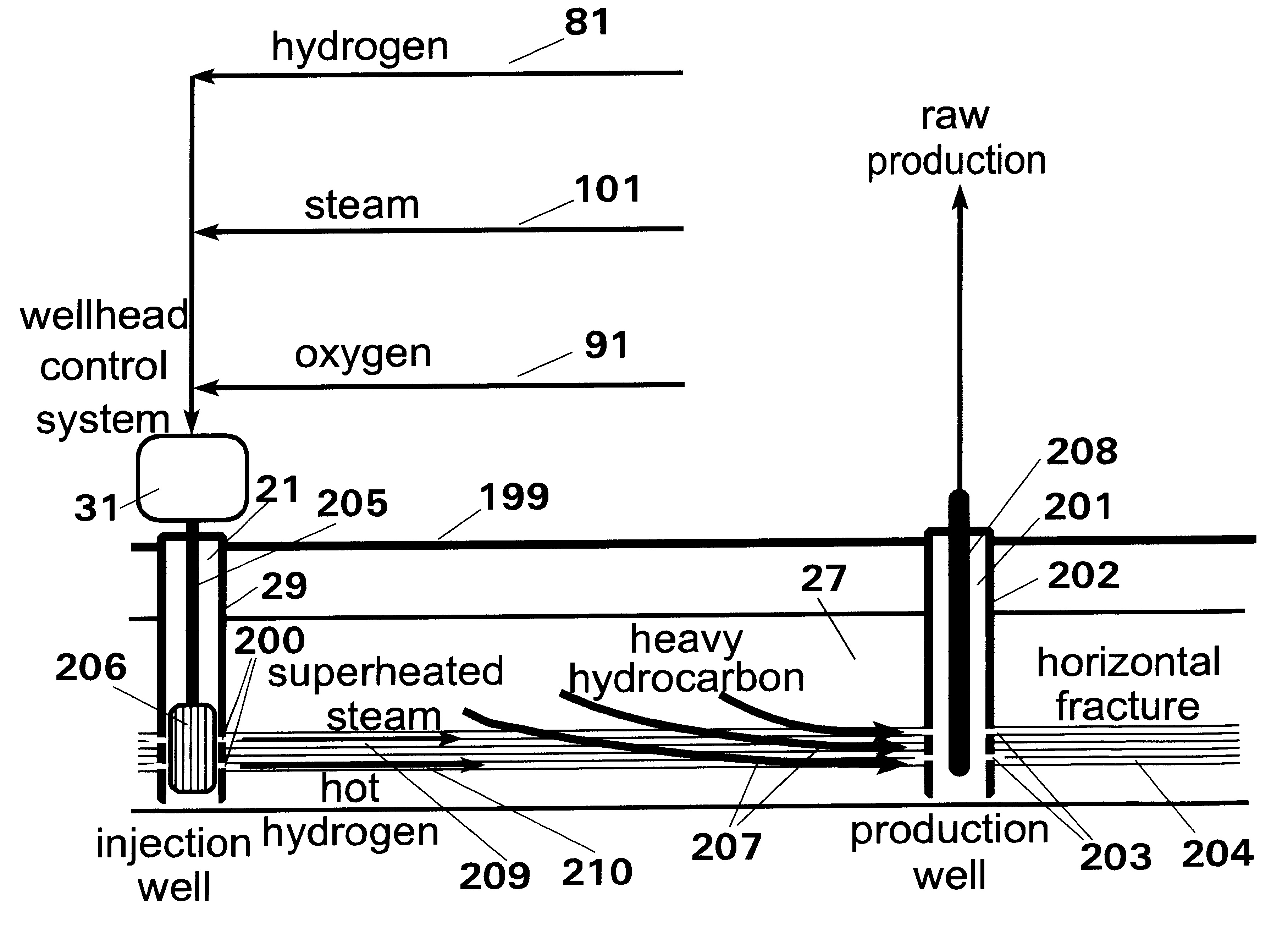Upgrading and recovery of heavy crude oils and natural bitumens by in situ hydrovisbreaking
a technology of in situ hydrovisbreaking and heavy crude oil, which is applied in the direction of fluid removal, borehole/well accessories, insulation, etc., can solve the problems of inability to recover resources (herein collectively called "heavy hydrocarbons") economically with current technology, and the viscous hydrocarbons lack the mobility required for economic production rates, and the effect of enhancing the ability of the hydrocarbon reservoir to accept injected fluids
- Summary
- Abstract
- Description
- Claims
- Application Information
AI Technical Summary
Benefits of technology
Problems solved by technology
Method used
Image
Examples
example i
illustrates the upgrading of a wide range of heavy hydrocarbons that can be achieved through hydrovisbreaking, as confirmed by bench-scale tests. Hydrovisbreaking tests were conducted by World Energy Systems on four heavy crude oils and five natural bitumens [Reference 8]. Each sample tested was charged to a pressure vessel and allowed to soak in a hydrogen atmosphere at a constant pressure and temperature. In all cases, pressure was maintained below the parting pressure of the reservoir from which the hydrocarbon sample was obtained. Temperature and hydrogen soak times were varied to obtain satisfactory results, but no attempt was made to optimize process conditions for the individual samples.
Table 2 lists the process conditions of the tests and the physical properties of the heavy hydrocarbons before and after the application of hydrovisbreaking. As shown in Table 2, hydrovisbreaking caused exceptional reductions in viscosity and significant reductions in molecular weight (as indi...
example ii
illustrates the advantage of hydrovisbreaking over conventional thermal cracking. During the thermal cracking of heavy hydrocarbons coke formation is suppressed and the yield of light hydrocarbons is increased in the presence of hydrogen, as is the case in the hydrovisbreaking process.
The National Institute of Petroleum and Energy Research conducted bench-scale experiments on the thermal cracking of heavy hydrocarbons [Reference 7]. One test on heavy crude oil from the Cat Canyon reservoir incorporated approximately the reservoir conditions and process conditions of in situ hydrovisbreaking. A second test was conducted under nearly identical conditions except that nitrogen was substituted for hydrogen.
Test conditions and results are summarized in Table 3. The hydrogen partial pressure at the beginning of the experiment was 1,064 psi. As hydrogen was consumed without replenishment, the average hydrogen partial pressure during the experiment is not known with total accuracy but would ...
example iii
indicates the viability of in situ hydrovisbreaking when applied on a commercial scale. The continuous recovery of commercial quantities of San Miguel bitumen is considered.
Bench-scale experiments and computer simulations of the application of in situ hydrovis-breaking to San Miguel bitumen suggest recoveries of about 80% can be realized. The bench-scale experiments referenced in Example II include tests on San Miguel bitumen where an overall liquid hydrocarbon recovery of 79% was achieved, of which 77% was thermally cracked oil. Computer modeling of in situ hydrovisbreaking of San Miguel bitumen (described in Example IV following) predict recoveries after one year's operation of 88 to 90% within inverted 5-spot production patterns of 5 and 7.2 acres [Reference 3].
At a recovery level of 80%, at least 235,000 barrels (Bbl) of hydrocarbon can be produced from a 7.2-acre production pattern in the San Miguel bitumen formation. Assuming the produced hydrocarbon serves as the source of hy...
PUM
 Login to View More
Login to View More Abstract
Description
Claims
Application Information
 Login to View More
Login to View More - R&D
- Intellectual Property
- Life Sciences
- Materials
- Tech Scout
- Unparalleled Data Quality
- Higher Quality Content
- 60% Fewer Hallucinations
Browse by: Latest US Patents, China's latest patents, Technical Efficacy Thesaurus, Application Domain, Technology Topic, Popular Technical Reports.
© 2025 PatSnap. All rights reserved.Legal|Privacy policy|Modern Slavery Act Transparency Statement|Sitemap|About US| Contact US: help@patsnap.com



